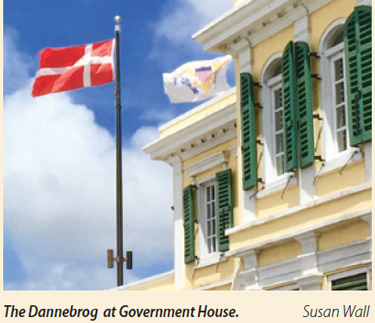by Nina York
Soon it will be one hundred years since Denmark sold our islands to the United States, but judging from the amount of activity planned and visitation to the islands from Denmark, you would never believe that such a divestiture took place!
Is it a sentimental attachment to the past, or perhaps even regret that our lovely islands no longer belong to Denmark, a small country of slightly over five million inhabitants that once possessed a colonial empire many times its current size?
Although huge Greenland and the Faeroe Islands are still officially linked to Denmark, Denmark once had possessions in Africa, India, owned Iceland, Norway, parts of southern Sweden, and parts of northern Germany. By comparison, our little islands are minor, but in terms of their one time value to Denmark’s economy, they played a major role at a time when the income from sugar cane, a major crop of the Danish West Indies, as we were called between 1733 and 1917, reached dizzying heights until the appearance of sugar beets came to play a great competitive role.
 Strangely, Denmark’s possession of these islands for such a long period and providing such economic bounty to the mother country has not been written up in Danish history books. It is quite possible that the not so politically correct element of having engaged in slave trade and employing without compensation many thousands of Africans brought here against their will under horrific conditions may have been a source of embarrassment for Denmark.
Strangely, Denmark’s possession of these islands for such a long period and providing such economic bounty to the mother country has not been written up in Danish history books. It is quite possible that the not so politically correct element of having engaged in slave trade and employing without compensation many thousands of Africans brought here against their will under horrific conditions may have been a source of embarrassment for Denmark.
But history needs to be recognized and seen as a lesson rather than being ignored. Also, the Danish period brought many positive elements, not least the impressive architectural heritage that is seen today in the Christiansted National Historic Site’s Fort Christiansvaern, the Old Customs House, the Old Scale House, the Steeple Building (has everyone noticed the working clock chiming on the hour?) and not least the Danish West India and Guinea Company Warehouse and Slave Market. It is also found in other official buildings such as the old Military Barracks on Christiansted’s Hospital Street that in a joint Denmark-USVI project are being restored with the goal of making the complex an academy of the building trades; another official gem of a building is the old Danish School in Frederiksted.
Let us also realize that unlike other islands of the Caribbean, our visitation from Denmark has mushroomed; Denmark now provides the second largest group of visitors to the islands, after the United States. Happily, it is generally agreed among Danish visitors that the Virgin Islanders are very friendly, which has come as a surprise to many. And seeing the Dannebrog, as the Danish flag is known, flying next to the Stars and Stripes and Virgin Islands flag at Government House is a very emotional and uplifting experience to every Danish visitor.
